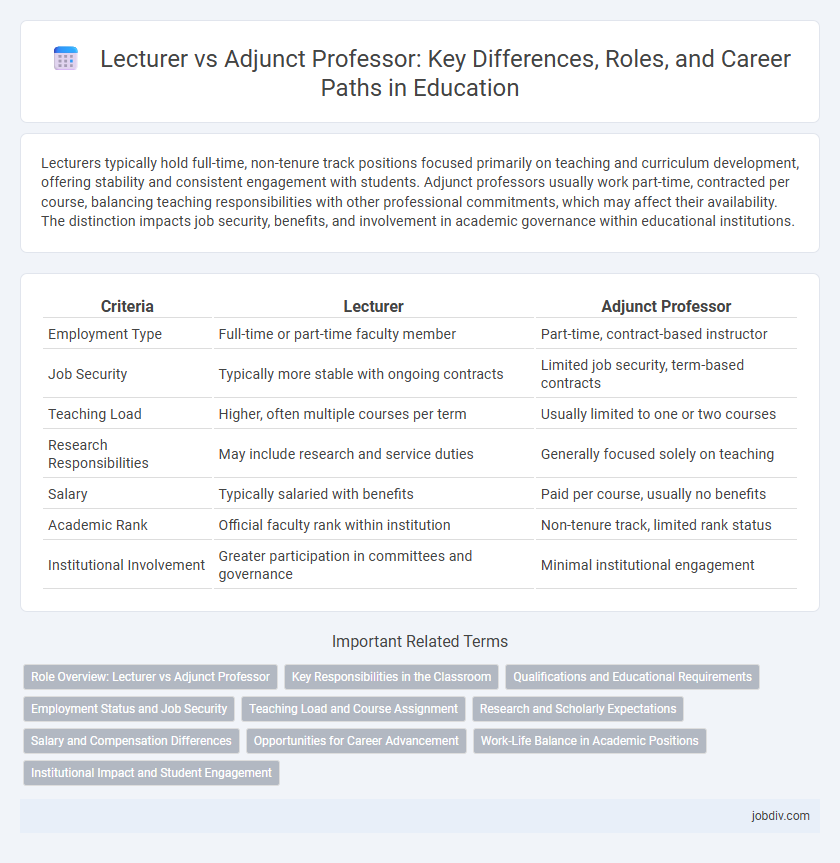Lecturers typically hold full-time, non-tenure track positions focused primarily on teaching and curriculum development, offering stability and consistent engagement with students. Adjunct professors usually work part-time, contracted per course, balancing teaching responsibilities with other professional commitments, which may affect their availability. The distinction impacts job security, benefits, and involvement in academic governance within educational institutions.
Table of Comparison
| Criteria | Lecturer | Adjunct Professor |
|---|---|---|
| Employment Type | Full-time or part-time faculty member | Part-time, contract-based instructor |
| Job Security | Typically more stable with ongoing contracts | Limited job security, term-based contracts |
| Teaching Load | Higher, often multiple courses per term | Usually limited to one or two courses |
| Research Responsibilities | May include research and service duties | Generally focused solely on teaching |
| Salary | Typically salaried with benefits | Paid per course, usually no benefits |
| Academic Rank | Official faculty rank within institution | Non-tenure track, limited rank status |
| Institutional Involvement | Greater participation in committees and governance | Minimal institutional engagement |
Role Overview: Lecturer vs Adjunct Professor
Lecturers typically engage in full-time teaching with a focus on curriculum development and student assessment, often holding permanent positions within academic institutions. Adjunct professors serve part-time, hired on a contractual basis to teach specific courses without extensive involvement in departmental responsibilities or research. The distinction lies in employment status and scope of duties, impacting job security and institutional integration.
Key Responsibilities in the Classroom
Lecturers primarily focus on delivering course content, designing curriculum, and assessing student performance through exams and assignments, ensuring a comprehensive learning experience. Adjunct Professors often balance teaching responsibilities with professional careers outside academia, bringing practical expertise into the classroom while typically handling fewer courses than full-time faculty. Both roles require effective communication and student engagement, but lecturers usually have more involvement in academic advising and curriculum development.
Qualifications and Educational Requirements
Lecturers typically hold a master's degree and possess substantial practical experience in their field, while adjunct professors are often required to have a doctoral degree or terminal degree relevant to their discipline. Both roles emphasize specialized knowledge, but adjunct professors generally engage in research and higher-level academic teaching, reflecting stricter educational qualifications. The distinction in qualifications influences curriculum depth and academic contribution, shaping the learning environment in higher education institutions.
Employment Status and Job Security
Lecturers typically hold full-time or long-term contracts with universities, offering greater employment stability and job security compared to adjunct professors, who are often hired on a part-time, contractual basis with limited benefits. Adjunct professors face higher job insecurity due to the temporary nature of their appointments, lack of tenure, and reliance on course availability each term. Employment status differences significantly impact income continuity and career advancement opportunities in higher education institutions.
Teaching Load and Course Assignment
Lecturers typically carry a heavier teaching load, often responsible for multiple courses each semester, focusing primarily on undergraduate instruction and regularly scheduled classes. Adjunct professors usually have a lighter teaching load, teaching fewer courses per term, often part-time, and may be assigned specialized or elective classes based on their expertise. The course assignment for lecturers tends to be more consistent and extensive, while adjunct professors receive more variable and flexible teaching schedules.
Research and Scholarly Expectations
Lecturers primarily focus on teaching responsibilities with limited research and scholarly expectations, often engaging in curriculum development and student mentorship. In contrast, adjunct professors typically balance part-time teaching duties with active research agendas, contributing to academic publications and conference presentations. Research output and scholarly involvement are crucial criteria for adjunct appointments, reflecting their dual roles in education and academia.
Salary and Compensation Differences
Lecturers typically receive a lower salary compared to adjunct professors, with median annual pay varying widely based on institution and location. Adjunct professors often earn per-course compensation without full-time benefits, averaging between $2,000 to $7,000 per course, while lecturers may have salaried positions offering more stable income and access to benefits such as health insurance and retirement plans. Salary differences reflect contract types, job security, and institutional roles, impacting overall compensation and career advancement opportunities in higher education.
Opportunities for Career Advancement
Lecturers typically have limited opportunities for career advancement due to the non-tenure track nature of their roles, often focusing on teaching without research obligations. Adjunct professors face similar constraints but may leverage multiple part-time positions to build diverse professional networks and gain varied teaching experience. Securing a tenure-track or full-time faculty position remains the primary path for both roles to achieve significant career growth and job security in academia.
Work-Life Balance in Academic Positions
Lecturers typically have more structured schedules and fewer research obligations, contributing to better work-life balance compared to adjunct professors who often juggle multiple part-time roles with unpredictable hours. Adjunct professors face greater job insecurity and inconsistent workloads, which can increase stress and limit personal time. Institutions offering stable contracts and clear expectations improve the work-life balance of both academic roles.
Institutional Impact and Student Engagement
Lecturers, often full-time faculty, contribute significantly to institutional stability through consistent curriculum development and robust student mentorship, fostering long-term academic growth. Adjunct Professors bring specialized industry experience and flexible teaching models, enhancing student engagement with real-world applications but may have limited institutional influence due to part-time status. The balance between Lecturers' sustained institutional impact and Adjuncts' practical insights shapes a dynamic educational environment that supports diverse learning outcomes.
Lecturer vs Adjunct Professor Infographic

 jobdiv.com
jobdiv.com